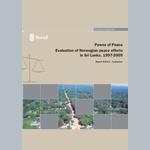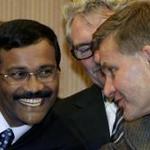Mission Impossible: The arduous road to peace in Sri Lanka
In 1999, Norway was invited by the Government of Sri Lanka and the Liberation Tigers of Tamil Eelam (LTTE) to broker a settlement of the longlasting ethnicised conflict. The Norwegian involvement in Sri Lanka started several years earlier. In the the early stages, the involvement was based on informal personal relationships.
The peacebuilding efforts turned out to be more difficult than anticipated, and came to a stall on several occasions. In 2008, the political unrest in Sri Lanka exploded into a full-blown civil war. The civil war came to a tragic end in May 2009. LTTE were cornered and had a human shield of hundreds of thousands of civilians who were not allowed to escape. According to estimates from the International Crisis Group, more than 30 000 people lost their lives during the last few months before the LTTE was defeated.
-Initially, when Norway first became involved in the Sri Lankan peace process, there were favourable conditions for building peace, but this opportunity represented only a very brief window of opportunity, says Gunnar Sørbø, senior researcher at the Chr. Michelsen Institute (CMI) and head of the evaluation team from CMI and the School of Oriental and African Studies (SOAS) who has evaluated the Norwegian efforts in Sri Lanka.
Fragile from the start
The Norwegian strategy had several weaknesses, according to Sørbø. Firstly, neither of the combating parties felt any ownership to the peacebuilding process. The government and the LTTE entered into the peace process while staying committed to their cause. Hence, the process was fragile from the start. The Norwegians perceived themselves as mere facilitators, and never ensured that the government or the LTTE were committed to resolving the conflict.
Adding to the problems, was the fact that the Sri Lankan president, the army, the Muslim population and ethno-nationalistic factions were put on the sidelines. This lead to discontent, and mobilisation against the peace process. Eventually, this changed the political landscape in Sri Lanka.
The skepticism towards Western involvement grew, and the Norwegian peacebuilding attempts were attacked both by the local media and by many leading politicians in Colombo.
In April 2009, the Sri Lankan government asked Norway to step back from the peace process. The CMI-SOAS evaluation concludes that Norway should have backed out from the process as early as 2006.
According to Sørbø, Norway’s reluctancy to let go of the process has moral implications:
-Norway was being used as a pawn of peace, and should have considered the ethical implications of continuing the role as facilitator and mediator more thoroughly.
An important lesson
The evaluation concludes that no external party could have succeeded in bringing peace to Sri Lanka. The attempts were futile due to a combination of unfortunate factors. The parties were not strongly committed to the peace process, specific characteristics of Sri Lankan political culture complicated the process, and a series of events like the split in LTTE, the tsunami and the 9.11 terror attack, complicated matters even further.
However, the Norwegian experience in Sri Lanka yields important lessons for peacebuilding efforts elsewhere. Mediators need to keep in mind that peace processes can produce unforeseen and unintended consequences, and that there is a cost to mediation.
Norway chose the role as a soft power mediator, and was not able to push an agreement ahead. Soft power may be a suitable approach to bring parties to the negotiation table, but is a much more challenging when trying to reach a settlement. In addition, the Norwegian team played various and not always compatible roles. In order to succeed and combine multiple roles, depends on a more robust strategic framework, the evaluation argues
The evaluation raises the question whether the Norwegian style of mediation is out of date. The Sri Lankan peace process reflect broader global changes. It ended with an "Asian model "of conflict resolution, based on ideas of sovereignty and without intervension, and was supported by China and others. This may inspire other countries in the region to follow in the footsteps of Sri Lanka, and could change the premises for Norwegian contributions to peace processes in other parts of the world.
Pawns of Peace. Evaluation of Norwegian peace efforts in Sri Lanka, 1997-2009
Publication

Pawns of peace. Evaluation of Norwegian peace efforts in Sri Lanka, 1997-2009
Project

